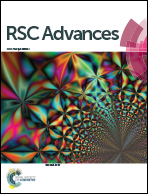Violet-light stimulated synaptic and learning functions in a zinc–tin oxide photoelectric transistor for neuromorphic computation†
Abstract
In contrast to the commonly present UV light-stimulated synaptic oxide thin-film transistors, this study demonstrates a violet light (wavelength of 405 nm) stimulated zinc–tin oxide (ZTO) photoelectric transistor for potential application in optical neuromorphic computation. Owing to the light-induced oxygen vacancy ionization and persistent photoconductivity effect in ZTO, this device well imitates prominent synaptic functions, including photonic potentiation, electric depression, and short-term memory (STM) to long-term memory (LTM) transition. A highly linear and broad dynamic range of photonic potentiation can be achieved by modulating the light power density, while electric depression is realized by gate voltage pulsing. In addition, the brain-like re-learning experience with extended forgetting time (200 s) is well mimicked by the ZTO photoelectric transistor. As a result, the ZTO photoelectric transistor provides excessive synaptic function with multi-series of synaptic weight levels (90 levels for each given light power density), which makes it prevalent in the neuromorphic computation of massive data as well as in learning-driven artificial intelligence computation.



 Please wait while we load your content...
Please wait while we load your content...